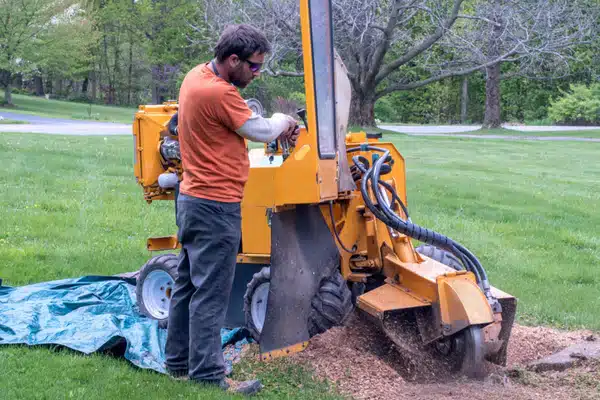
That old tree stump in your yard might seem harmless, and stump grinding might feel optional. But leaving it there creates more problems than you think and can reduce accessibility. Tree stump removal and stump grinding isn't just about aesthetics, it's about safety, health, and making the most of your outdoor space.
When a tree comes down, many homeowners focus on clearing the branches and trunk, not on future landscaping projects or planting needs. The stump gets forgotten. This oversight can cost you later in safety hazards, pest problems, and missed opportunities for your yard.
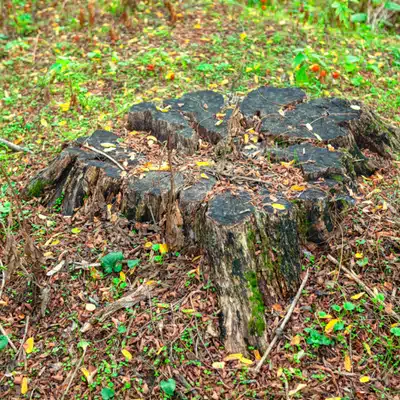
Tree stumps create serious safety hazards in your yard. A low-cut stump becomes a tripping hazard when grass or leaves hide it from view. Kids running around, pets playing, or guests walking through your yard could easily trip and get hurt.
The liability concerns are real too. If someone gets injured on your property because of a stump, you could face legal trouble. Beyond personal injury, stumps wreak havoc on lawn care equipment. Hit a stump with your mower and you might damage the blades or motor.
Proper stump removal requires strict safety precautions. The removal process involves heavy grinding equipment and sharp tools like a chainsaw or axe. Without the right training, these tools can be dangerous. Many homeowners find that hiring professionals is safer than attempting DIY removal.
Professional crews wear protective gear and clear the area before starting work. They cut the stump flush to the ground, then use specialized equipment to finish the job. For most homeowners, this approach beats the risk of injury from unfamiliar tools.
Old stumps become magnets for unwanted visitors. As wood decays, it creates perfect conditions for termites, carpenter ants, and beetles. These pests don't stay put - they spread to healthy plants and even your home.
Termites are especially problematic. They love nesting in old stumps and can send out swarmers that target wooden structures nearby. What starts as a decaying stump becomes a launching pad for home invasion.
Tree diseases pose another threat. If you removed a sick tree, the stump might still harbor those same pathogens. Fungi growing on stumps release spores that can infect other plants in your yard. Some root rot diseases survive in dead stumps for over 30 years, waiting to attack new trees you plant nearby.
Stump grinding eliminates these breeding grounds. It removes the wood that pests and diseases need to survive. This protects both your landscaping and your home from future problems.
Many stumps also try to regrow. Species like maple, oak, and willow send up new shoots from remaining roots. These weak sprouts create ongoing maintenance headaches. Complete stump removal prevents this tree sprout prevention issue entirely.
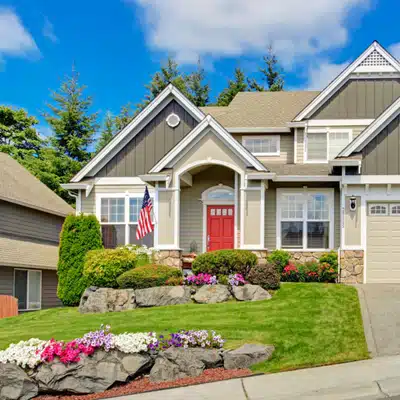
Stumps hurt your yard's appearance. They stick out like eyesores in otherwise beautiful landscaping. From the street, a dead stump disrupts the clean lines and lush growth that make yards attractive.
This matters for property value too. Real estate experts note that visible stumps can lower home values or turn off potential buyers. People see stumps as extra work and expense they'll have to handle. A well-maintained yard signals that the property gets proper care.
Removing stumps opens up new possibilities for your space. That freed area could become a garden bed, extend your lawn, or support new landscaping projects. Many homeowners discover creative uses for space once stumps are gone.
The aesthetics improvement happens immediately. Your yard looks cleaner and more polished without dead wood interrupting the view. This kind of home improvement project delivers quick visual returns that you'll enjoy every day.
Space utilization becomes a real issue when stumps take up prime real estate. The stump and its underground root system occupy valuable ground that you could use better. Want to build a deck, install a playground, or create a vegetable garden? That stump will get in your way.
Construction projects become complicated when old stumps and roots interfere. It's much easier to remove stumps before starting new work than trying to build around them. Even smaller projects like pathways or irrigation systems run smoother without root obstacles.
The root system can also threaten underground utilities. As roots decay, they leave voids that might affect water lines or sewer pipes. Removing stumps protects your infrastructure from future problems.
For lawn care, stumps make routine maintenance harder. Mowing around obstacles wastes time and leaves uneven grass. Once stumps are gone, you can run equipment in straight lines and keep your lawn looking uniform.
Your accessibility improves too. People with mobility needs can navigate more easily across level ground. Equipment like wheelbarrows and spreaders move freely without stump obstacles.
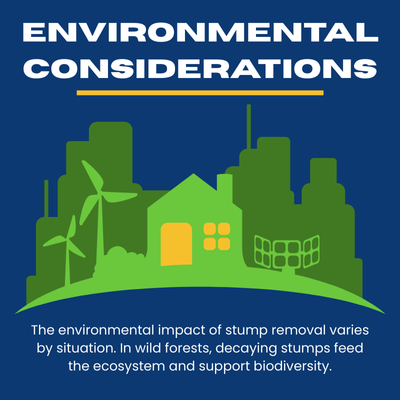
The environmental impact of stump removal varies by situation. In wild forests, decaying stumps feed the ecosystem and support biodiversity. They return nutrients to soil and provide habitat for wildlife.
But residential yards aren't forests. The same decay that benefits nature becomes problematic near homes. The slow nutrient release doesn't outweigh the pest and disease risks for most homeowners.
Stump grinding actually creates useful byproducts. The wood chips left after grinding make excellent mulch for garden beds and pathways. Instead of buying mulch, you can repurpose the stump material.
However, mixing wood chips directly into soil can temporarily reduce soil quality. As chips decompose, they tie up nitrogen that plants need. Professional removal includes topsoil installation to fix this issue. Fresh soil ensures new grass or plants can thrive immediately.
Chemical removal methods offer an alternative but work slowly. These treatments might speed decay by only 25% compared to natural decomposition. You'll still wait months or years for results, and chemicals require careful handling around children and pets.
Stump grinding represents the most common removal method. Crews prepare the area by clearing debris and cutting stumps as low as possible. The grinding process uses rotating cutting wheels to chip away wood systematically.
Operators move the stump grinder back and forth across the stump, reducing it to chips. They grind several inches below ground level to ensure complete removal. The grinding process is loud but fast - most stumps disappear within an hour.
Full stump removal takes a different approach. Heavy machinery like excavators pulls out the entire stump and major roots. This method works best for construction sites where any remaining wood could cause problems. For established yards, grinding usually provides sufficient results with less disruption.
Equipment rentals are available for DIY enthusiasts, but professional service often proves more cost-effective. Experts have powerful machines and know how to avoid utility lines. They also handle debris removal and site cleanup as part of the job.
After grinding, crews typically include grass seeding and soil restoration. This ensures your yard heals quickly and looks seamless. Within weeks, you won't see any trace of the old stump.
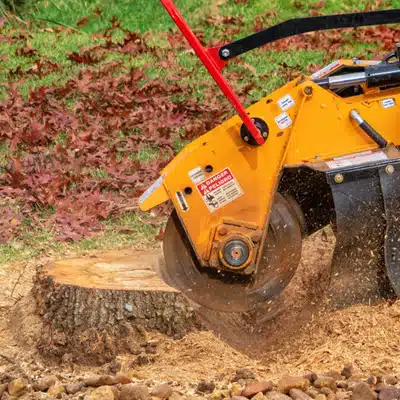
Stump removal delivers multiple benefits that improve your property immediately and long-term. You eliminate safety risks, prevent pest problems, and gain usable space for new projects. The landscaping benefits include easier maintenance and better aesthetics that boost your home's appeal.
Professional removal costs less than dealing with the ongoing problems stumps create. Pest control, equipment repairs, and landscaping limitations add up over time. Removing stumps upfront prevents these headaches.
The removal process has improved significantly with modern grinding equipment and techniques. What once took days now happens in hours, with minimal yard disruption.
Don't let old stumps limit your yard's potential or create safety risks for your family. Professional stump removal transforms problem areas into opportunities for better landscaping and safer outdoor living.
Ready to reclaim your yard? Contact a us today for a free stump removal estimate. Your family's safety and your property's value are worth the investment.